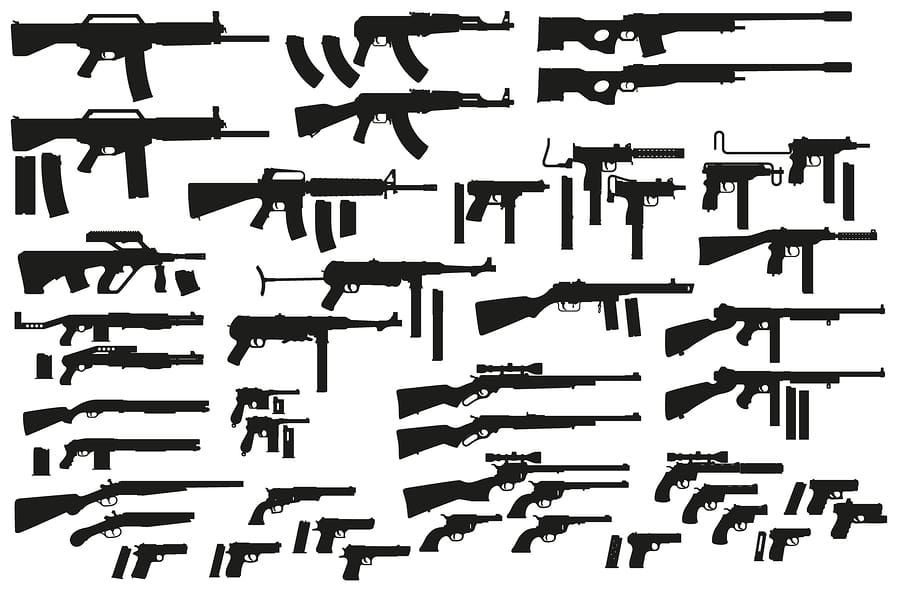The hand cannon: it’s what it sounds like…not a Desert Eagle, but an actual handheld cannon. Hand cannons were rudimentary and brutish, but they were the first firearms used during combat in recorded history.
Gun Powder or Medicine?
Although there have been claims of gunpowder’s “discovery” in Europe, the ancient Chinese are generally credited with the original recipe.
In 618 A.D. Daoist scholars discovered that, when lit, a mixture of sulfur, potassium nitrate (also known as saltpetre), and charcoal would explode. At the time, they were in search of a way to make their emperor live forever, and the explosive mixture was dubbed ‘fire medicine’.
As one might imagine, “fire medicine” didn’t turn out to be the key to eternal life. So, until the tenth century, the powdered mixture was used mostly to make fireworks.
The Early Hand Cannons of China
There’s still plenty of dispute about where the first hand cannon made a bang (pun intended), but let’s go with what was recorded first.
Gunpowder made its shift from firework display to military asset in 907 A.D. during the Tang Dynasty. Long bamboo tubes were filled with gunpowder and attached to spears. They were then lit, and thrown at an enemy who would suffer from burns and from the impact of any other projectiles in the bamboo tube (iron pellets, clay shards, or stones, to name a few). These exploding spears were known as fire lances.

The hand cannon came a little later, in the twelfth century, and were made mainly of bronze. These early guns clocked in at around 8 lbs, with a length of about 14 inches, and an inner barrel diameter of an inch. The guns were either handheld, or placed on a wheeled cart. Because there was no automatic way to light the gunpowder, hand cannons often required two people for proper operation. One soldier would hold and aim the cannon, while another would ignite the gunpowder with smoldering bits of wood or coal, white hot iron rods, or matches.
Early projectiles were crude, and the firearm’s aim was poor at best. When fired, bits of gravel or pottery would discharge over vast areas, often scattering around the intended target. However, the smoke, fire, and the roar certainly intimidated if not injured opponents (especially those on horseback).
By the 1500s, hand cannons evolved into what we would think of today as cannons. They were anchored to the ground, and were more accurate, more powerful, and could be fired rapidly. These cannons were over 2 feet long, and weighed upwards of 50 pounds. Cannonballs were filled with gunpowder so they would explode on contact. Some were filled with arsenic or ammonia to poison or blind the target.
The Early Hand Cannons of Europe
Despite evidence that the Europeans acquired gunpowder from the Mongols or from the Arab Muslim world, English scholar Roger Bacon was credited with inventing gunpowder in 1242 A.D. The earliest, reliable evidence of Europeans using firearms followed early in the next century.

The European hand cannon began very much the same as their Chinese counterparts, and didn’t differentiate until the early 1400s. While the Chinese dove into a rapid fire, rotating multi-cannon design, the Europeans sought firing automation within a single cannon.
The term “lock, stock, and barrel” comes from the three major components of early European firearm design. The lock is a mechanical firing mechanism. You may know of them as flintlocks, matchlocks, or firelocks. The stock is a wooden holder in which the barrel is mounted, allowing the gun to be fired while resting on the shoulder, or fired from one hand. The barrel is self-explanatory.

The matchlock of the early fifteenth century was the first hand cannon to incorporate all three. The mechanical firing device was called a serpentine, and was an s-shaped arm that held a match. A trigger device would lower the serpentine, and a lighted match would fire priming powder in a pan attached to the side of the barrel. The flash of fire in the pan would penetrate a small breach in the barrel of the gun, igniting the main charge.
Perhaps the greatest achievement of the matchlock was freeing the hands of the cannon user’s aid. That meant more cannons in the hands of more people.
Still, the matchlock wasn’t without it’s disadvantages. Igniting the main charge of the gun was somewhat slow, and, as one can imagine, it was difficult to keep the match alit in the wind or rain. Ambushes were also less ambush-y, as the glow from the lit match would alert any awaiting targets.
Nevertheless, the matchlock hand cannon remained the primary military firearm in Europe even after other automated ignition systems were invented.
The Hand Cannon as a Teacher
Since then, hand cannons continually evolved into the automatic, lightweight firearms of today.
It would seem few inventions have had as decisive and dramatic an impact on human affairs as has gunpowder. Before gunpowder, human combatants or hunters were limited by their amount of muscular strength. Gunpowder and firearms enabled a more tactical approach.
By the scientific revolution of the nineteenth century, gunpowder combustion provided an instructive guide for steam-powered engines. Steam power relied on the ability of mechanized iron cylinders to precisely and repetitively fire within predetermined internal dimensions; this method was derived from cannon-boring techniques.
Whether you credit the Chinese or the Europeans for them, the hand cannon of yesterday is what has shaped our firearms, and our world, today.
Jackie Clark is a history and lifestyle blogger from Portland, OR. You can read more of her work here.






damn, so the chinese had frags-on-a-stick? awesome
Rudimentary and brutish was the high tech cutting edge of of the 13th Century, hopefully our descendants will have the opportunity to ridicule our technology too.
Waitaminit…
I thought mass murder wasn’t invented until the machine gun came along?
Someone alert the media…
In most if not all of the Chinese imperial wars (I am no Chinese historian–this is second hand), a “no prisoners” rule was in effect. As a result, the reported figures of the dead (after the slaughter of the defeated army) wee in the hundreds of thousands, and sometimes even into seven figures. I assume that there was a certain amount of exaggeration involved, but who knows.
According to the media, mass murder was invented hand in hand with the AR15
Be sure to tell them mass murder was around long before the gun.
“These exploding spears were known as fire lances.”
As a note, a ‘fire lance’ today is usually considered a “thermal lance” and is a way to concentrate a *massive* amount of heat on a small area using Thermite.
https://www.youtube.com/watch?v=EV4r7OKkXmU
“It would seem few inventions have had as decisive and dramatic an impact on human affairs as has gunpowder. Before gunpowder, human combatants or hunters were limited by their amount of muscular strength. Gunpowder and firearms enabled a more tactical approach.”
Incorrect.
‘Tactical’ hunting was very much a thing, pre-gunpowder. Prey was frightened and herded into kill zones with humans acting in coordinated teams, terraforming was done by digging drop pits to kill them, and all kinds of other things.
Otherwise, nice article on early human history, thanks for sharing it…
We studied this in world history in the 8 th grade I think, my how times have changed. Do they teach history anymore?
Not really. In today’s schools kids are taught nothing of importance happened until the feminist wave of the 1970s.
fvc
Comments are closed.